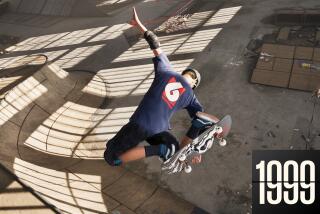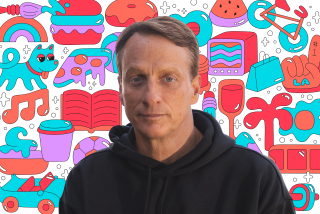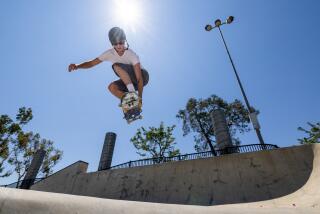Fearless Fliers of Fallbrook : The crowd-pleasing, dare-devil ‘skate gods’ soar through the air with practiced ease.
FALLBROOK, Calif. — Their shins are bruised and bleeding, but that’s a given in this endeavor: flying straight up 12-foot-high walls, throwing the body eight or 10 feet into the air, deftly turning a somersault or two in the ozone, then miraculously landing upright on the small, speeding projectile known as a skateboard.
They perform eye-popping, “intense air” tricks again and again, until they get tired or they “slam” (crash)--whichever comes first. This is full-on world-champion-level skateboarding, and these pros slam a lot. They all know how to fall. Then they yell at each other:
“Banzai!”
“Did you bend a tentacle or what?”
“I just got inverted.”
Bruises darken. Bleeding continues. Practice wears on. The closest thing to first aid is a swig of Gatorade or a gulp of straight aloe vera juice. The skaters say the blood bath is a daily occurrence. They wear protective helmets, wrist guards and kaleidoscope-colored kneepads to ward off more serious injuries. But there are no nets in skateboarding, no real protection from the Masonite, the half pipes or the asphalt far below. There are no pools of water to cushion a fall. No spotters. And no uncool, sissy stuff either, such as long pants or protective tights.
Not for the skate gods--highly paid, globe-trotting, crowd-stunners who will skate anything. Banisters. Benches. Elevated bridge supports. Hand rails. And increasingly, enormous, $30,000, custom-built ramps installed in their own back yards.
But who would have thought the gods would also skate Fallbrook, the tiny Southern California village that is the home of the two most exciting skateboard pros in the world: 21-year-old Tony Hawk, the smooth, undisputed king who has dominated the sport so long he’s sometimes called the Wayne Gretzky of skateboarding, and 15-year-old Danny Way, the youngest pro on the skate circuit, the kid who’s said to be Hawk’s heir apparent. Impatient, aggressive and afraid of almost nothing, Way has been dubbed “Evel Knievel” by his own mother.
The two have astounding skate ability, high pain thresholds and Fallbrook in common. But with its seven stoplights, Fallbrook--population 26,000--is far from being what “wheelheads” would term the deepest, steepest, meanest, gnarliest, freakiest, most shreddable, down, happenin’ skate town in the universe.
According to Neil Feineman, a college professor-turned-writer who’s working on a history of skateboarding, communities worthy of such superlatives are usually urban jungles situated on the California coast: Santa Monica. San Diego. Santa Cruz. San Francisco. San Jose, if you’ve got to venture inland.
Bucolic little Fallbrook is 45 minutes east of the Pacific, equidistant from San Clemente and Oceanside--rural territory full of horses and rolling hills. A tractor pull would seem more at home here than hell-bent, world-class skateboarding.
The village bills itself as “the avocado capital of the world” and is known for such residents as Hall of Fame baseball player Duke Snider and white supremacist Tom Metzger, the former California Ku Klux Klan grand dragon.
But to the estimated 10 million young Americans who ride skateboards, Fallbrook might as well be the capital of the skateboard nation. Although most skateboarders--including Hawk and Way, who live 20 minutes apart--are friendly competitors, there is brewing here a gentle but undeniable rivalry.
In fact, in the opinion of some observers, virtually every skateboarding pro is watching Way very carefully and perhaps already feeling a bit threatened.
“Danny’s the hottest thing in skateboarding,” says Mark Hunt, the skater/producer responsible for “SK8TV,” a skateboarding special airing on the Nickelodeon network. “The other skaters are scared of him because he’s younger than they are and he’s as good as they are.”
Way doesn’t have any titles yet, Hunter notes, “but he’s only 15 and he can do everything the older pros can do.”
“And more,” affirms Mark (Gator) Anthony, who at 23 has been ranked among the world’s top five vertical skaters since 1984. (Vertical or ramp skating is considered the most spectacular and difficult form of the sport; it is Anthony’s, Hawk’s and Way’s specialty.)
“I remember seeing Danny years ago at Del Mar Skate Ranch when he could barely kick-turn (the most basic skateboard maneuver). It’s ironic now that he’s teaching me tricks,” says Anthony, a popular pro who did the skating for actor Christian Slater in the 1989 feature film “Gleaming the Cube.” Like Hawk and Way, Anthony also wound up living in Fallbrook.
Recently, though, he bought a house on the beach in Carlsbad and sold his Fallbrook home for $350,000 when local zoning regulations wouldn’t allow him to build a warehouse on his property (he wanted it to enclose his private, indoor, rain-or-shine skate park).
But what drew these champions to Fallbrook in the first place?
Initially, some say, it was the legendary but now-closed Fallbrook Ramp.
“The ramp was at the home of a kid who had a rich father and built the ramp. It was the best ramp in the area. All the pros started going there in ’87 (and) Fallbrook became skate central for San Diego,” says Alec Schroeder, managing editor of Poweredge, a skateboard magazine based in Carson, Calif.
The ramp was closed a couple of months ago, after the owner’s son lost interest in skating.
But by then, Hawk had moved to Fallbrook with his girlfriend, Cindy Dunbar. And the star now being called “the skateboarder of the decade” soon had his own, state-of-the-art ramps built on his gated property--at an estimated cost of $30,000.
Like many Southern California communities, Fallbrook is not renowned for its street-skating opportunities. “If you try to do it, the police will stop you. When we skate in Fallbrook it usually doesn’t last more than half an hour. The police stop us,” says Hawk, a tall, thin, gracious host, whose home-plus-ramps has become a hangout for a number of top skaters.
Way, Anthony and other professionals practice there on occasion. Some, usually members of the close-knit Powell-Peralta team that sponsors Hawk, practice at Hawk’s ramp more frequently, sometimes daily.
Two professional skaters live with Hawk and his girlfriend. The house is stylishly decorated with light, airy colors and contemporary furnishings. Filled with Hawk’s extensive collection of computers, video games and electronic gadgetry, it rivals his back yard as a wonderland of cutting-edge technology.
There are no ordinances outlawing back-yard skate parks in Fallbrook, where, in areas such as Hawk’s neighborhood, the smallest land parcel anyone can purchase is two acres. Even so, to keep his distant neighbors happy, Hawk disguised his largest ramp as a tennis court, surrounded it with green netting, and soundproofed it as much as possible to diminish the “rolling thunder” the neighbors claimed it produced.
Danny Way was 13 and still an amateur skateboarder when his family moved to Rainbow, part of the Fallbrook Post Office area, about two years ago. At the family home he shares with older brother Damon Way, their mother, Mary O’Dea, and her boyfriend, Steve Van Deusen, Danny is in the midst of helping with the construction on a huge set of ramps, the latest in a series he’s personally built since he started skateboarding at 2 1/2.
“I couldn’t keep him off the skateboard,” recalls O’Dea, noting that she was a maximum-strength hippie when Danny was born. In those days, the family lived in a tepee in the San Francisco area. Danny and Damon’s father, Dennis Way, who made custom guitars for such stars as Johnny Winter and Carlos Santana, died when Danny was only eight months old.
About a year later, O’Dea married Tim O’Dea, and Danny soon began scooting around on his stepfather’s skateboard. Now divorced, O’Dea remembers what happened when she used to hide her son’s skateboard: “He’d scream when I took it away from him.”
When Danny was six years old, his mother would accompany him to Del Mar Skate Ranch, where he, Hawk, Anthony and other local daredevils skated.
“I used to go to Del Mar and scream and leave because I thought they were going to kill themselves,” she remembers.
But Del Mar Skate Ranch closed in 1985 because of insurance problems. Most other public skate parks have since shut down for similar reasons, forcing the serious skaters to find private facilities.
Like Hawk, Way occasionally skated at the super-fast Fallbrook Ramp. In the last few years, his practice sessions have been chiefly at Mike McGill’s Skate Park in Carlsbad, a 45-minute drive from Fallbrook, one of the last remaining public skate parks in Southern California. The park is co-sponsored by the Boy Scouts.
Now, however, Way’s own giant ramps are nearing completion. The lumber alone cost him $7,000.
Unlike Hawk, who declines to talk about how much money he makes (the National Skateboard Assn. estimates the income of its top pros to be about $250,000 a year), Way is frank on the subject--and on anything else he’s asked.
He doesn’t hesitate to say that he’s made about $30,000 in his first eight months as a professional skateboarder. Most of that’s from commercial endorsements, videos and demonstrations. He has three skateboards of his own design on the market--sold through H-Street, one of his corporate sponsors.
Ask the skater, who resembles a thin, blonde Beaver Cleaver, about the dangers of the sport, and he matter-of-factly replies, “I get hurt every day. You only feel the pain on impact.” He’s similarly succinct on the subject of girlfriends. “No way!” he shouts. His mother confirms his disinterest: “He made the mistake of kissing a girl goodby in Acapulco last year, and she started calling him. He told me to tell her that he moved. Or died.”
Indeed, Way seems almost exclusively focused on thrill sports. When he’s not flying on a skateboard or designing new ones, he’s usually out riding one of his three motorcycles, snow boarding or surfing.
For the moment, he’s enrolled in a high school independent studies program in Vista (“Danny’s pretty much been a straight-A student,” says his mom). But in February, he expects to take the G.E.D. test for high school equivalency so that when he turns 16 in April, he won’t have to participate in the independent study program.
That will leave him even freer to travel and concentrate on his skating career--not to mention the one he’d also like to pursue in Motocross motorcycle riding.
In Way’s first eight months as a pro, he placed first in the vertical competition at one meet, and he picked up two third-place awards in other contests. In 1989, Hawk received first prizes at six of the eight contests he entered, including the Scandinavian Open in Copenhagen and the Titus Cup in Munster, Germany. He also placed first in vertical skating at the recent national finals in Florida. And while he’s not as well known for his street-style skating, he also finished first in the street-style skating division at the finals.
By contrast, Way finished ninth in vertical skating at the finals and 22nd in the finals’ street-style competition. Neither skater competed in the less popular freestyle competition.
How does one reconcile all the hoopla over Way with such erratic results?
According to Tony Magnusson, a top-rated skater who owns H-Street, the big difference between Way and Hawk is experience and consistency. Especially at contests. “Danny doesn’t have as much experience as Tony does to skate a contest,” explains Magnusson, who holds the Guiness Book of World Records’ record for a skateboarder’s “highest air” (distance flown above a ramp), which he says is officially 9 1/2 feet and unofficially about 11 feet.
“Danny will push the limits on tricks (and fall) more often than Tony does, and you lose points for falling,” Magnusson continues. “The weakest thing about Danny’s skating is that he’s 15 years old and he’s an impatient kid. But all in all, he’s got everything he needs to be the world’s best skateboarder one day.”
Along with ability, Way also has a volatile temper. He readily admits it, but points out that he doesn’t throw his board anymore when upset with his performance.
Says coach/sponsor Magnusson: “Instead of throwing his board, he’ll run and jump against the ramp with his head. It’s like saying, ‘I don’t steal cars anymore, I just rob banks.’ He gets real frustrated. The ability of his mind is definitely ahead of the ability of his body, which is a good problem to have.”
As far as comparisons with Hawk, Way says, simply, “He’s the best. When I get older, I want a house and stuff, but I don’t want to compare myself to Tony. I want to be the best I can be.”
In Hawk’s view, the alleged rivalry has already been blown out of proportion.
“I think people make a bigger deal of it than it really is,” he says with characteristic diplomacy. “It’s flattering in a way. I don’t know. (Danny) is a different person. I didn’t set any goals for myself in (skating).”
Stacy Peralta, Hawk’s coach and co-owner of Powell-Peralta, a leading skateboard firm, recalls a period in Tony’s life that may shed some light on how the champ could react to increased heat in the coming months and years.
“A couple of years ago, Tony said to me, ‘I don’t want to compete anymore,’.He said, ‘Everyone shoots for second place because they know I’m going to win. I can’t deal with this pressure,’ ” says Peralta, a skateboard legend in his own right who set records in the sport in the 1970s, much as Hawk has done in the ‘80s.
Says Hawk: “That (conversation occurred) also because people thought that if Tony Hawk didn’t get first, he lost. If you get second or third in a professional contest, I don’t think by any means you’ve lost. I didn’t necessarily quit then. I just took it easy for a while.”
But Frank Hawk, Tony’s father and founder of the National Skateboard Assn., knows precisely how smart (I.Q. 144) and how willful a competitor his son is.
“There were times,” says the elder Hawk, “when I literally dragged Tony out of (an empty swimming) pool when he wouldn’t quit (skating). He’d have a knee swollen-up like a balloon and I’d have to carry him out, telling him ‘Tony, there’s another day. . . .’ ”
“We had him when we were both at advanced ages. My wife was 43. I was 45. Our other children were nearly grown. We call him a do-it-yourself grandchild. We had problems when he was little. He’d throw out baby-sitters when he was two or three. We were concerned. What were we doing wrong? When he was little, he wasn’t mellow like he is now. He’s a competitor. He doesn’t want to lose.”
On the other hand, Frank Hawk also points out that he’s had more than one discussion with Tony about the eventual likelihood of being displaced by a hotter hotshot.
“Tony’s attitude is that if a kid out-skates him, a kid out-skates him,” says the father. “He skates to satisfy himself. He’s just on another level.”


